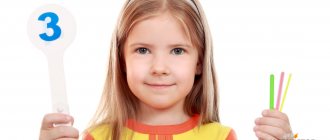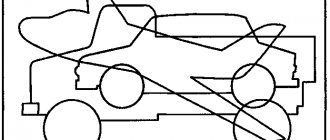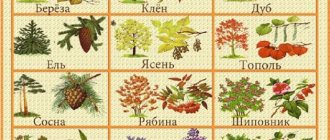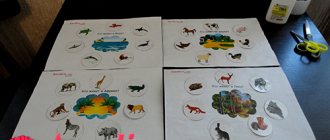Progress of the lesson:
I.
Introductory part:
1. Organizational point:
Time for business, time for fun. Listen to my story. I’ll sit up straight, I won’t bend, I’ll get to work! Check, my friend, are you ready to start the lesson? 2. Announcement of the topic and purpose of the lesson:
The topic of our lesson is “Dishes”. Let's get acquainted with the dishes.
II. Main part:
1. Game “sly spoon”.
Place utensils in front of the child: a plate (faience), a spoon (metal), a cup (glass) - and name each item. Ask the child to show objects and ask: “What is this?”
We will play with a spoon, tap the spoon on the plate: And name the dishes. "This is a plate." Knock with spoon
Close your eyes, take a cup.
Guess why the spoon is knocking? The child closes his eyes and listens to sounds.
Shows the dishes that were knocked on. Trying to give names to the dishes. (Loka, taka, cha-chaka)
2. Game "What is this."
The speech therapist invites the child to examine and show, then name the dishes (as best he can, without paying attention to articulation)
Items: teapot, cup, spoon, knife, plate. “I will... drink from a cup.” (child repeats: pp-pi)
“I’ll... eat from the plate (yum).” “I will use a knife...?” (cut-rr eat)
3. Physical exercise.
“Get up, let’s rest!”
I take the cup in my hands,
And I bring it to my mouth,
I tilt my head (performs the movements behind the speech therapist, independently)
I drink the tea to the bottom.
Well done. Sit down.
4. Game “Assignment”.
The child is standing at the table. Speech therapist: “Take a cup.” “What did you take? "
- cup. (chaku)
- "What did you do?" (took and dropped)
So continue with each of the dishes.
III.
Final part.
- Activity assessment: You were active in class. Well done, keep trying.
- Summing up: What dishes did you learn today? (child answers).
- Homework: written in an individual notebook: (play with dishes, learn to name each type)
Summary of an individual speech therapy session with a 4-year-old child.
Topic: "Wild Animals".
Purpose: to cause onomatopoeia;
Tasks:
- develop auditory attention,
- further development of the thoraco-abdominal type of breathing,
- activate vocabulary on the topic,
- develop fine motor skills and constructive praxis.
Equipment: toys or pictures with wild animals, cut-out pictures on the topic.
Alalia motor. Speech therapy classes, work with children with alalia.
A child with motor alalia has a high level of non-verbal intelligence (he understands everything), verbal intelligence is in its infancy (he does not speak or speaks little and poorly) and high emotionality (recently, some scientists have identified this as a separate type - emotional intelligence). Such a child, in most cases, from one and a half to three years of age is very kind, affectionate, and sociable, and after four, when he realizes that he is different from his peers, he becomes withdrawn, shy or aggressive.
I am engaged in the formation of verbal intelligence (speech) through intact understanding, logic and emotions. In correctional pedagogy there is such a principle - working through intact analyzers, for example, when working with sensory alalia, they immediately begin to teach reading in order to form an understanding of “sound”, audible speech through the intact visual analyzer.
Emotions: in an integrated approach, I indicated several ways that affect emotions to increase a child’s motivation, which are more effective than for children with mental retardation and sensory alalia.
I start work with the first words and lexical topics that are emotionally significant for the child. Every child has his favorite toys: some play with cars, some with “little animals”; girls prefer dolls and ponies. Therefore, it is worth asking the parents about the child’s preferences and building the first lessons on their basis: firstly, the child will make contact faster, and secondly, perhaps in his topic he already has some words or onomatopoeia with which he can communicate , and thirdly, by typing words on this topic, the child will be able to immediately include them in his play and life, he will more actively use and consolidate them.
History. Boy, 4.5 years old, motor alalia, in the active dictionary - mother, woman, give, several onomatopoeias. His passion was trams and trains. We drew them, built them from cubes, rolled them... The first word called up was the word “coupling” - connecting the cars to each other. (It turns out that he was interested not so much in trains as in the way the cars were connected). Then came a very quick set of vocabulary: driving, buzzing, carriage, train, road….
Logic: the difference between understanding speech and active speech in motor alalitics has its own characteristics. At first, such children are confused with children with developmental disabilities or considered simply lazy (“he doesn’t want to talk”). Recalling the first words through simple repetition does not work (as it does with ZRR and SA). Often, even after “talking,” a child with MA can repeat words or phrases after the speech therapist, but he does not use them independently in speech or in life. In order to form independent speech, we work:
— through questions (with SA we explain and repeat 80% of the time and ask 20% of the time, and with MA it’s the other way around)
- a large number of repetitions both when calling out words, and when forming phrases, and when working with cases in the future occurs due to the use of a large number of situations where the use of this word, case, etc. is required, and not just repetition of the same thing
Symptoms of sensory alalia
The sensory alalik is not at all silent. Children have active—sometimes even overly—expressive speech. However, at the same time, they are absolutely not critical of their statements, not understanding themselves what exactly they are saying.
Characteristic features of sensory alalia:
- The mindless repetition of frequently heard phrases is echolalia. The child may persistently repeat advertising slogans, words of cartoon characters, etc. Sometimes speech may seem meaningful if the child repeats the last word he heard along with the answer. But if you change the phrase, there will be no result.
- Frequent confusion of words, syllables and phrases, the use of made-up words - the so-called logorrhea - is another characteristic symptom of sensory alalia.
- In most cases (about 70%), hearing remains intact. However, there is instability of auditory attention. In addition, many alaliks suffer from hyperacusis - increased sensitivity to certain sounds.
- Phonemic speech perception is impaired. That is, the chain through which auditory excitation is transmitted to brain structures associated with speech “does not work” in the child.
- There are also some memory impairments. In order to remember a word or phrase, alalik requires quite a lot of repetition.
So, speech with sensory alalia is absent not because the child has disorders of the auditory or speech or articulatory apparatus, but due to the inability to form a connection between the sound of a word and an object.
Correction of sensory alalia
Classes to correct this condition are structured depending on its severity. A severe form of alalia, resulting from significant damage to areas of the brain, the child is completely unable to analyze sounds and, accordingly, understand the surrounding speech. A lighter state allows children to be aware of individual words, but not to isolate them in phrasal speech or, conversely, to perceive situationally remembered sentences and not understand words used independently.
To correct sensory alalia, a speech therapist must conduct an examination to correctly determine the severity of the condition and build a lesson plan that includes the necessary exercises and tasks.
Severe forms of this condition can lead to secondary mental and intellectual development disorders, so it is important to find a specialist who will help the child develop his speech.
www.Logopedy.ru
Author : Tropko Evgeniya Sergeevna, teacher-speech therapist, MBDOU kindergarten No. 3 “Zvezdochka” of combined type, city. Noginsk, Moscow region
Original:
The essence of speech therapy work is not to teach alalik the rules of grammar, writing, reading, but to instead of the disturbed channels of speech activity, include those that have been preserved, make them work harder, perform double or even triple the workload. Such a complex task requires frequent use of various pre-language skills. These are gestures, rhythmic movements, drawing, imitation of non-speech sounds, for example, the howling of the wind, the voices of animals. As these skills are mastered, the child is introduced to speech-like sounds and words that gradually become more complex in meaning. Techniques for such work are available only to highly qualified specialists, and parents can only help speech therapists here, but not replace them. Speech therapy work for alalia should begin early, as soon as a child’s lag in speech development is noticed, since speech is not formed independently and without the help of a speech therapist. In any case, the absence of speech by the age of 2 is already an alarming signal.
In case of sensory alalia, speech therapy is aimed at nurturing a conscious analysis of the composition of speech, the development of phonemic perception, and understanding of speech structures.
When teaching children with sensory alalia, special methods are used aimed at developing activity, forming sound and morphological analysis and the semantic side of speech. This takes into account the level of underdevelopment of understanding, one’s own speech, cognitive activity, and general characteristics of the child’s personality.
The main principle of the work is a consistent and systematic impact on all aspects of the child’s speech activity in their interrelation. The work is effective only when the doctor carries out specific treatment that normalizes the activity of the central nervous system and stimulates the maturation of cells in the cerebral cortex.
Stage 1.
The work begins not with perception, but with the development of attention. The child is taught non-verbal facial tasks: Seguin board, tracing, coloring, mosaic, drawing, shading, making pictures from cubes, stringing beads. At the same time, we are working on developing efficiency and observation skills. At this stage, the child’s activity should be non-speech.
Stage 2.
They learn to distinguish and differentiate sounds that are similar in sound, a sound noise series of more distant sounds to closer sounds of a non-speech nature (bell, drum, rattles, tambourine, hitting a glass with a spoon, hitting a table). Gradually the sound and noise range increases and becomes more complex. For example, distinguishing the noise of compressed paper and polyethylene film.
Stage 3.
Inclusion of a strong, monotonous speech sound in the sound-noise series: r-r-r-r. As soon as the child begins to isolate a speech sound from the noise range, this sound materializes through one of the toys (dog, vacuum cleaner, airplane, etc.). Moreover, it materializes only through one specific toy. Then the following sound is taken: a-a-a, it is also determined and materialized through a specific picture. All sounds are repeated, speech sounds are especially emphasized, and at the same time we enter a letter. As a result, the child must, through a specific picture, show the letter “R” with the sound “P” (airplane). For the sound “A”, show the doll and the letter “A”. At this stage, we constantly establish a connection between the sound image and the letter.
Stage 4.
We include syllables in the work. Children learn syllables that can be used to designate objects: ball - pa-pa-pa, cow - mu-mu-mu, dog - aw - aw - aw. Images of objects must be specific and colorful, in appropriate colors. Learning at this stage is global and holistic. We move from syllables to words. MAC, JUICE, - pictures - letters. The child learns to distinguish words that are distant in meaning (transport-poppy). In parallel with this work, a list of standard instructions for everyday use is being compiled. “Get a handkerchief. “Wipe your nose” - pronounced with the same intonation, repeatedly against the background of a series of sound and noise. We definitely help the child with a gesture - “open the door”, highlight it with intonation, and show the sign. Training is carried out using a conditioned reflex method, through reinforcement of sounds and actions, through demonstration of instructions and display of instructions on tablets. A set of physical exercises is taught with speech accompaniment “arms up, arms to the sides.....”.
Stage 5.
Work is carried out along logical, thematic chains. All exercises are performed in microdoses. In milder cases, work is being done to develop phonemic hearing. Isolating a specific sound from a number of sounds: a- y- O- t-p. , syllable emphasis: SA-RA-SHA-da. Next, we select a word from a series of words: garden-house-COM-cancer. We arrange pictures with a given sound at the beginning of the word, in the middle, at the end. We select pictures from the dictionary for a specific sound. Game “Chain of words” MA——lina
——rina
--tire.
Determine the linear sequence of sounds.
It is easier to identify and distinguish sounds in someone else's speech than in your own. Sounds should be pronounced at intervals. Then the child must name the whole word: R_U_CH_K_A. The child must learn to merge sounds into words and retain sounds in memory.
Individual plan for corrective development of a child
for the 2021 – 2021 academic year Last name, first name of the child _______________________________________________
Year of birth ______________________ Year of study ________________
Conclusion of the PMPC _________________________________________________
Tasks:
1. Development of speech understanding 2. Development of active imitative speech activity 3. Development of general speech skills 4. Development of phonemic hearing
Development of speech understanding
Teach your child:
1. Find objects and toys at the request of the teacher.
2. According to the speech therapist’s instructions, recognize and correctly show objects and toys.
3. Show body parts as requested by an adult.
4. Understand general categories:
· work is carried out primarily on specific material (and not pictures) in a life situation; · it is necessary to achieve true understanding, and not rote memorization: the concept of “transport” is formed not only from a picture book or from cards, but also on the street, at the station, etc., the concept of “vegetables” is reinforced at the market, in the grocery store, etc.
5. 5. Show and perform actions related to the outside world, familiar everyday or play situations:
· actions according to verbal instructions: “Show me where auntie is? Here she is! Show me where your aunt's eyes are? Here they are! Show me where your aunt's hands are? “Here they are”; · tasks based on speech instructions, including 1-2-3 actions (Take the doll. Take the doll and give it to Masha. Take the doll, put it at the table, feed it); · tasks based on speech instructions, including spatial relationships between objects: on, under, in, behind (example: “Put the car on the table. Place the matryoshka doll under the chair. Find the doll, it’s in the closet. Bring the car, it’s under the table, etc.) .
6. Strengthen the skill of conducting a one-way dialogue (the speech therapist asks a question about the content of the plot picture, and the child answers it with a gesture).
7. Perceive the questions in a differentiated manner: who?, where?, where from?, with whom?.
8. Understand the categories of singular and plural nouns and verbs.
9. Distinguish by ear appeals to one or more persons.
10. Understand the categories of gender of singular past tense verbs: Valya was reading a book.
11. Guess objects, toys, animals, birds based on their verbal description (big, brown, club-footed, lives in a den, sucks a paw).
12. Understand the functional meaning of objects. At the request of an adult, select objects to perform the named actions (cutting - knife, sewing - needle, pouring soup - ladle).
13. Determine cause-and-effect relationships (snow - sleds, skates, snow woman).
Lexical topics: “Toys”, “Clothing”, “Furniture”, “Dishes”, “Food”, “Transport”.
Development of active imitative speech activity
Teach your child:
1. Name parents, relatives (mom, dad, grandma).
2. Name the names of friends and dolls.
3. Cause speech imitation on vowel sounds and their combinations (Katya sings: a-a-a; The train is humming: o-o-o; Parsley is surprised: o-o-o; The mouse squeaks: i-i-i; In the forest shout: au; Baby cries: wa; Donkey screams: ya.)
4. Reinforce the pronunciation of the same syllables: Yes, yes, yes! Ba-ba-ba-ba! Mom mom! Pa-pa-pa-pa!;
5. Create onomatopoeia with the voices of animals and sounds of the surrounding world
· based on open syllables: cow - mu; mouse - pi; finger - bo-bo; car - beep; gus - ha-ha-ha; chicken - ko-ko-ko; · based on closed syllables: ball - bang; dog - aw-aw; gnome - yum-yum; kettle - puff-puff; · based on the material of syllables with a consonant cluster: frog - kva - kva - kva; duck - quack, quack, quack; piglet - oink, oink-oink, etc.).
Successful sound complexes are repeated in a playful manner several times (up to 5-10 repetitions).
6. Clear expression of your desires:
· “Yes”, “No”. · “I want”, “I don’t want.” · “I will”, “I won’t.”
7. Point to certain objects: here, this, here.
8. Give orders: here, go, give
9. Make up first sentences, for example: Here is the ball. This is Danya.
10. Express your needs with a simple phrase (2-3 words) in a specific situation: “Auntie, give me!”, “Kolya, go to the ball,” “Mom for a walk,” “Let’s go to bed.”
11. Make sentences according to the model: address + imperative verb: Mom, sleep.
12. Convert imperative verbs into verbs of the present tense singular number of the 3rd person (sleep - sleeps, go - goes).
13. Reflect in speech in a form accessible to the child the results of observations in nature and in everyday life (“Where was Daniel? Walking. What did he see there? Snow. Who did he walk with? Nanny. What is the nanny’s name? Aunt Galya. Who did he see? Lena.)
14. When reciting nursery rhymes, poems, rhymes to adults, perform certain actions, learn finger games with speech accompaniment: for example, rhymes: “We shared an orange, there were many of us, but he was one. This slice is for the hedgehog, this slice is for the siskin, and this one is for Masha”; “The mice came out one day to see what time it was. One, two, three, four, the mice pulled the weights, suddenly there was a terrible ringing, the mice ran away,” and others.
A game. “ For pancakes ”: (the child’s name is called) began to gather guests. - Claps your hands, then the right, then the left hand on top. - And Ivan come, And Stepan come, And Andrey come, And Matvey come. – The tip of the half-bent index finger of the right hand hooks in turn the tips of the half-bent fingers of the left hand, starting with the thumb, and gently shakes them. - And Mitroshechka: Well, please! — the index finger of the right hand persistently shakes the little finger of the left hand four times. Anya began to treat the guests: Damn it to Ivan, Damn it to Stepan, Damn it to Andrey, Damn it to Matvey, and Mint gingerbread for Mitroshechka!” - Claps your hands, then the right, then the left hand on top. The left hand is turned palm up, the thumb of the right hand presses on the pads of each finger of the left, starting with the thumb, as if placing a pancake. Anya began to see off the guests: “Goodbye, Ivan!” - Goodbye, Stepan. - Goodbye, Andrey! - Goodbye, Matvey! The fingers of the right hand bend the fingers of the left towards the palm, starting with the thumb. - And you, Miroshechka, my little one, stay with me a little longer! The first three fingers of the right hand gently stroke the little finger of the left from top to bottom.
Gradually, the child should begin to try to independently name the corresponding word. It is important to encourage any, even the most distorted, reproduction of it. At the same time, the speech therapist correctly and clearly repeats this word after the child.
In this case, special techniques are used to help actualize speech:
· the appearance and sudden disappearance of an object that was first named, and then the question is asked - What is it? Who is this? Who was hiding?; joint pronunciation of the word; · reflected speaking; · finishing a word in a situation that suggests the right word.
Development of general speech skills
Formation of the optimal type of physiological diaphragmatic breathing for speech.
1. Form speech breathing (calm short inhalation and smooth long exhalation):
· Without speech accompaniment (for example, “Let’s smell the flower”, “Ships”, etc.) · With speech accompaniment (based on vowel sounds and their combinations, isolated voiceless fricative consonants /F/, /X/, syllables with these consonants, words , later - gradually spreading phrases, the pronunciation of which requires a continuous, long exhalation (3-4 words).
2. Develop voice strength (quiet - loud) and voice modulation (high - low).
3. Develop the correct moderate tempo of speech (speech with movement, singing with movement).
4. Form primary ideas about the intonation expressiveness of speech through emotional reading to the child of nursery rhymes, poems, and fairy tales.
5. Develop the ability to convey accents by hitting a tambourine, clapping your hands and maintaining pauses.
6. Teach intonation imitation of the voices of animals and birds.
7. Teach to reproduce the intonation-rhythmic pattern of a word while simultaneously tapping the syllables with hand movements.
8. Teach expressive storytelling of nursery rhymes, short poems, and fairy tales.
9. Activate the movements of the articulatory apparatus and facial muscles in the process of performing articulatory imitation exercises in a playful manner:
· “Smile” - Keeping your lips in a smile. The teeth are not visible. · “Tube” - Stretching the lips forward in a long tube. · “Smile-pipe.” Pull your lips forward with a tube, then stretch your lips into a smile. · "Dissatisfied horse." The flow of exhaled air is easily and actively sent to the lips until they begin to vibrate. The result is a sound similar to the snorting of a horse. · “Fat men.” Inflate both cheeks, then inflate the cheeks alternately. · “Skinny girls.” Pull in your cheeks. · "Ball". Mouth closed. Hitting the puffed-out cheeks with your fist, causing the air to come out with force and noise. · "Spatula". The mouth is open, a wide, relaxed tongue rests on the lower lip. · "Cup". The mouth is wide open. The anterior and lateral edges of the wide tongue are raised, but do not touch the teeth. · "Needle". The mouth is open. The narrow, tense tongue is pushed forward. · "Fungus". The mouth is open. Suck your tongue to the roof of your mouth. · "Watch". The mouth is slightly open. The lips are stretched into a smile. With the tip of the narrow tongue, alternately reach at the teacher’s count to the corners of the mouth. · "Swing". The mouth is open. With a tense tongue, reach for the nose and chin, or the upper and lower incisors. · "Football". Mouth closed. With a tense tongue, rest on one or the other cheek. · "Brush your teeth". Mouth closed. Move your tongue in a circular motion between your lips and teeth. · "Horse". Suck your tongue to the roof of your mouth and click your tongue. Click slowly and firmly, pulling the hyoid ligament. · “Delicious jam.” The mouth is open. Using a wide tongue, lick your upper lip and move your tongue into the back of your mouth.
Development of phonemic hearing
1. Teach the child to distinguish non-speech sounds and their direction:
· tapping; · patting; · rustling of paper; · door creaking; · tambourine sounds; sounds of a metallophone; sounds of maracas · sounds of the toy (squeaking).
2. Teach differentiation by ear:
· nouns whose names differ in one sound. The child shows the pictures named by the speech therapist: mouse - bowl; roof - rat; daughter - dot; · nouns that differ in several sounds and are similar in sound-syllable structure: donkey - goat; donkey - goat; lawn - carriage; snake - earth; cart - nose; · verbs that sound similar (the speech therapist asks questions about the “story” pictures): who rides - who bathes; who bathes - who buys; who they graze - who they carry; who carries - who carries.
3. Teach the child to identify by ear the sound complexes “Mocking a doll (a-a-a-a)”, “Sore ear (o-o-o-o)”, “Echo” (lost in the forest - ouch), “Tearful” baby" (wa-wa) among other sound combinations.
Social commentary Cackle
Tasks and exercises for sensory alalia
Speech therapy classes are conducted as part of complex therapy. At the same time, given that the violation is systemic in nature, work is being carried out “on all fronts.” The classes necessarily include exercises for the development of motor skills, attention, memory, and phonemic hearing.
It is important to consider that for children with sensory alalia, uncontrolled sound sources only slow down the correction process, overloading the psyche and not having any speech impact. Therefore, the first thing the specialist recommends is organizing regular “quiet time” in the family and generally limiting the sound environment. Against such a depleted sound background, the child’s sensitivity to speech increases. This state is used during classes.





